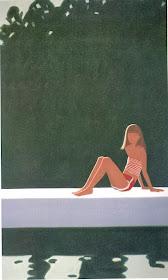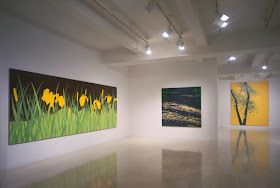Check out the tranquil + serene simplicity within the Landscapes of,
ABOUT
Alex Katz was born in Brooklyn, New York in 1927. In 1928, at the outset of the Depression, his family moved to St. Albans, a diverse suburb of Queens that had sprung up between the two wars. Katz was raised in St. Albans by his Russian parents. His mother had been an actress and possessed a deep interest in poetry and his father, a businessman, also had an interest in the arts. Katz attended Woodrow Wilson High School for its unique program that allowed him to devote his mornings to academics and his afternoons to the arts. In 1946, Katz entered The Cooper Union Art School in Manhattan, a prestigious college of art, architecture, and engineering.
in A. K.'s studio
At The Cooper Union, Katz studied painting under Morris Kantor and was trained in Modern art theories and techniques. Upon graduating in 1949, Katz was awarded a scholarship for summer study at the Skowhegan School for Painting and Sculpture in Maine, a grant that he would renew the following summer. During his years at Cooper Union, Katz had been exposed primarily to modern art and was taught to paint from drawings. Skowhegan exposed him to painting from life, which would prove pivotal in his development as a painter and remains a staple of his practices today. Katz explains that Skowhegan’s plein airpainting gave him “a reason to devote my life to painting.”
Katz’s first one-person show was held at the Roko Gallery in 1954. Katz had begun to develop greater acquaintances with the New York School and their allies in the other arts; he counted amongst his friends’ figurative painters Larry Rivers and Fairfield Porter, photographer Rudolph Burckhardt, and poets John Ashbery, Edwin Denby, Frank O’Hara, and James Schuyler. From 1955 to 1959, usually following a day of painting, Katz made small collages of figures in landscapes from hand-colored strips of delicately cut paper. In the late 1950s, he moved towards greater realism in his paintings. Katz became increasingly interested in portraiture, and painted his friends and his wife and muse, Ada. He embraced monochrome backgrounds, which would become a defining characteristic of his style, anticipating Pop Art and separating him from gestural figure painters and the New Perceptual Realism. In 1968, Katz moved to an artists’ cooperative building in SoHo, where he has lived and worked ever since. He continues to spend his summers in Lincolnville, Maine.
- from alex katz.com
Mr. Katz is 86 and still going strong. Cheers* to A.K.
MORE*
Alex with his wife, ADA
My wife, Ada, is my muse. It just sort of turned out that way. She’s like Dora Maar [Picasso’s muse and lover]. She’s a perfect model - a European-American beauty. If she was two inches taller she could nail Miss America! When she was young she went to the movies and was very influenced - all her gestures come out of movies; she’s like a dancer, she doesn’t make a bad gesture. I am really lucky!
- a.K. ( PHAIDON interview)
- shots courtesy of Architectural Digest
A swanky danky ad for j.Crew. / A.K.'s The original Hipster***

Advice for aspiring painters
You’ve got to paint six days a week, six hours a day; you do that for six or seven years and you find out where you’re at. Painting needs a terrific application of energy, at least for me anyway. Also, if you don’t read what’s going on you’re never going to be a painter because you have to have some knowledge of things. You probably have to discard 50% of what you read by art historians but the other 50% you have to work on, you work for it or against it. When I learnt to draw, I drew around the clock for a couple of years. If I wasn’t eating or in school, I was drawing; I’d draw on dates and I’d be drawing at four in the morning coming back on the subway. With the application of mental and physical energy you can get better.
-A.K.
excerpt from PHAIDON interview
Some installation shots



A.K. at his home catching some rays with his painting
THANKS FOR ALL THE AMAZING WORKS A. K.
CHEERS*
you just saw the brilliant works of :
ALEX KATZ

































































